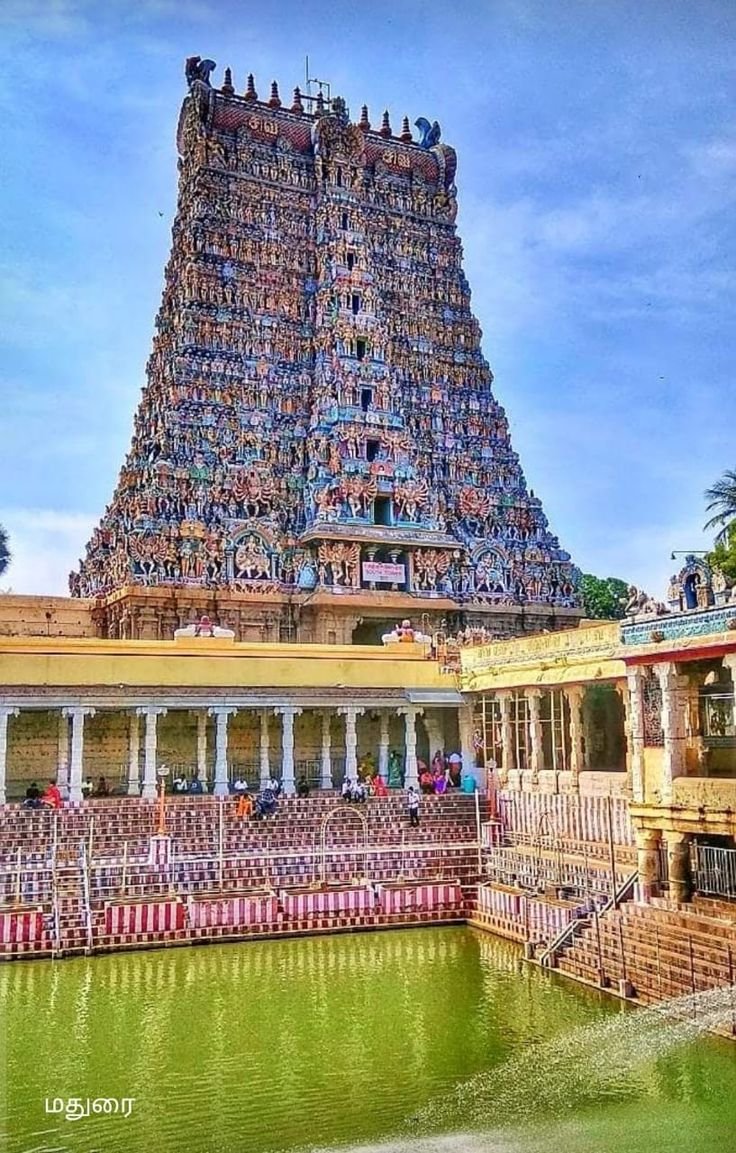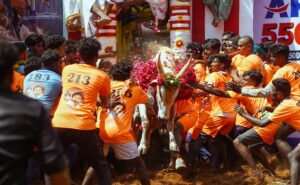A strongly revered spiritual center for pilgrims all over the world, Madurai Meenakshi Amman Temple is one of the world’s most renowned architectural masterpieces, hidden away in the bustling city of Madurai, Tamil Nadu. The temple is a tribute to India’s rich cultural legacy and a superb example of Dravidian architecture. This article extensively covers the history, architectural wonders, main attractions, and colorful festivals of the temple.
Section Summary
- Ancient History Of Madurai Meenakshi Temple
- Four Majestic Gopurams
- A Thousand Pillar Hall
- Lord Nataraja’s Velliambalam Statue: An Unique Icon of Grace
- Important Festivals
- Opening And Closing Timings
- How To Reach Through Train , Air , Bus
Ancient History Of Madurai Meenakshi Sundareshwarar Temple
The Meenakshi Temple in Madurai serves as one of the main pillars of Tamil history and culture, primarily because of its deep-rooted ancient origins. Dating back to the sixth century BCE in the Pandyas dynasty, the temple is built to honor Goddess Meenakshi, which is a manifestation of Parvati, and her spouse, Lord Sundareswarar, who is a manifestation of Lord Shiva.
Mythology has it that it is at the center of the city of Madurai, where some amount of celestial nectar, named Madhu, dropped off from Lord Shiva’s hair. Through centuries of expansions and renovations, especially during the reign of King Thirumalai Nayakar in the 17th century, the temple gradually evolved into the architectural wonder it is today..
The Madurai Meenakshi Amman Temple in Tamil Nadu, India, is an example of historical and architectural marvel constructed and enlarged over centuries by kings. Here is a quick summary:
- Pandya Dynasty (Early Construction And Major Contributions): The original design was supposedly made by the Pandya kings.
- Chola Period (Rebuilding and Enlargement): To add glory to the temple, the Chola period, 10th–12th century CE witnessed extensive enlargements and transformations.
- Vijayanagara Kingdom 14th and 17th century CE. Many of the ornate gopurams (tower entrances) were erected by the Vijayanagara kings in particular, King Krishna Devaraya played a significant role in their construction.
- Nayak Dynasty (18-19 Century) Final Flourish
Four Majestic Gopurams Of Madurai Meenakshi Amman Temple [Gateaways] In Mid Of The City
Most notable about the temple are its four imposing gopurams, gateway towers that dominate Madurai’s skyline. Thousands of vibrant sculptures depicting gods, mythical animals, and scenes from the Hindu epics adorn each elaborately carved gopuram.
- South Tower (Sundareswarar Gopuram): The tallest tower, standing at 170 feet with 1511 Statues each depicting deities, mythical creatures, and various scenes from Hindu mythology showcases intricate carvings and vibrant colors.
- East Tower (Meenakshi Gopuram): Dedicated to Goddess Madurai Meenakshi Mandir, this tower boasts sculptures that narrate her life and divine acts.
- West Tower (Chithirai Gopuram): Known for its relatively simple yet elegant design with The West Tower is about 66 feet tall and contains approximately 1,120 statues
- North Tower(Velli Gopuram or Silver Gopuram): Houses several mythological depictions and serves as the entrance to sacred inner areas.
The Thousand Pillar Mandapam [Hall]: A Structural Marvel
Housed within the temple complex is the iconic feature of Indian temples design With Thousand Pillar Mandapam. In fact, this hall contains 985 beautifully carved pillars, each meticulously crafted to showcase creative brilliance. Moreover, built during the Nayak period, it not only serves as an architectural marvel but also functions as a vital venue for religious and cultural activities.
- Architectural Perfection: The pillars are arranged in symmetrical rows, creating a sense of harmony and grandeur
- Artistic Intricacy: Each pillar is adorned with carvings of gods, goddesses, and mythical creatures
- Musical Pillars: Some pillars emit musical notes when tapped, showcasing the temple’s scientific and artistic brilliance
The hall now functions as a museum, displaying artifacts, statues, and scriptures that give visitors insights into the temple’s historical and cultural legacy
Lord Nataraja’s Velliambalam Statue: An Icon of Grace
“Normally Lord Natarajan Will Bless Us Raised The Right Leg And Standing With Left Leg But In The Velliambalam or Silver Hall In Madurai Meenakshi Sundareshwarar Temple It’s Viceversa” A houses a magnificent statue of Lord Nataraja, the cosmic dancer. This sacred icon has been depicted in a special pose to accentuate the grace and divinity of Nataraja .
Significance of the Velliambalam Statue
1.Represents the cosmic dance of creation, preservation, and destruction.
2. Crafted with intricate detailing, reflecting the artistic prowess of ancient sculptors.
3. A key attraction for devotees seeking blessings from Lord Shiva.
The divine energy radiating from this statue makes it a must-visit spot for spiritual seekers and art enthusiasts alike.
World Famous Festivals Of Madurai Meenakshi Temple And Opening & Closing Timings
Amidst the festive celebrations, the vibrant Meenakshi Amman Temple of Madurai comes alive, attracting millions of devotees every year. The most important among many are the Meenakshi Thirukkalyanam [Marriage] celestial wedding between Goddess Meenakshi and Lord Sundareswarar, which takes place in April. During this time, grand processions, cultural performances, and religious rituals are all part of the fiesta.
- Chithirai Festival: Celebrated in April-May, this festival commemorates the divine wedding and attracts pilgrims from far and wide.
- Navaratri: A nine-day celebration dedicated to the goddess, marked by special prayers and artistic performances.
- Aadi Velli: Fridays in the Tamil month of Aadi are celebrated with grandeur.
How To Reach Meenakshi Amman Temple Madurai
Nearest Airport To Meenakshi Amman Temple – Madurai Airport [IXM] 30 Mins From The Temple
Nearest Railway Station To The Temple – Madurai Railway Station 11 Mins
Temple Timings
| Opening Hours | Closing Hours |
| 5:00 AM | 12:30 To 1:00 PM |
| 4:00 PM | 9:30 To 10:00 PM |


![Shopping Streets In Madurai [Buy Gift For Her/Him]](https://maduraimirror.com/wp-content/uploads/2025/01/An-Young-And-Beautiful-France-Girl-Travel-And-Shopping-Freak-Shopping-In-the-Streets-Of-Madurai-19-01-2025-at-19-41-03-768x768.webp)
![Madurai Famous Foods Non Veg And Veg [Taste Now]](https://maduraimirror.com/wp-content/uploads/2025/01/Give-Me-Image-Of-Eye-catchy-Images-For-Authetic-Mutton-Briyani-Which-Is-Served-In-Long-Greeny-banan-17-01-2025-at-14-36-40-1-768x768.webp)
![Top 7 Best Gyms in Madurai [With Personal Trainers]](https://maduraimirror.com/wp-content/uploads/2025/01/Best-Gym-In-madurai-768x768.webp)

6 thoughts on “Madurai Meenakshi Amman Temple : Ancient History You Need To Know”
Comments are closed.